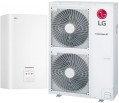Heat output (~ 0 °C)
Heat output is the amount of heat generated by a heat pump at a source temperature (air or ground - see above) of about 0 °C. This indicator is more visual and closer to reality than the maximum heat output (see above), so it is often indicated in the characteristics as the main one.
The required heat output depends on the area and some features of the room, on the need for hot water and a number of other factors; for its calculation in special sources, you can find the appropriate formulas.
Max. cooling output
Maximum cooling output delivered by the pump.
The pump operates in the cooling mode removing excess heat from the room to the environment — it plays the role of an air conditioner. The required cooling capacity depends on the area of the building, the specs of its thermal insulation and some other factors; methods of its calculation can be found in special sources. Also note here that conventional heating equipment (radiators, underfloor heating) is not suitable for cooling, for this it is necessary to use special equipment (for example, fan coil units).
Power consumption (heating)
Electric power consumed by the heat pump when operating only for heat transfer, without the use of an additional heating element (if any, see below). The ratio of thermal power to power input determines the thermal coefficient COP (see below) and, accordingly, the overall efficiency of the unit. It also affects overall power consumption (and therefore electricity bills), as well as some power and connection requirements — for example, models powered by 230 V and with a power of more than 5 kW cannot work from an outlet and require a special connection to the mains.
Minimum operating temperature
The lowest ambient temperature (air or ground, see Heat source) at which a heat pump can safely and reasonably efficiently perform its functions. Efficiency at minimum temperature, of course, is noticeably reduced, but the device can still be used as a heat source.
The data on the minimum operating T allows you to evaluate the suitability of the pump for the cold season.
Max. water temperature
The highest temperature to which the pump can heat the coolant. It is worth noting that such indicators can be achieved at a fairly high temperature of air or ground. And since heat pumps are used during the cold season, the actual maximum temperature, usually, is less than theoretically achievable. Nevertheless, this parameter makes it possible to evaluate the capabilities of the unit or its suitability for certain tasks.
COP
The COP (coefficient of performance) is a key characteristic that describes the overall efficiency of a heat pump. It represents the ratio between the thermal power and power consumption of the unit (see above) – in other words, how many kilowatts of thermal energy the pump produces per 1 kW of electricity consumed. In modern heat pumps, this figure can exceed 5.
However, note that the actual COP value may vary depending on the outside temperature and the supply temperature. The higher the difference between these temperatures, the more resources are needed to “pump” thermal energy and the lower the COP will be. Therefore, in the specifications it is customary to indicate the COP value for specific temperatures (and in many models – two values, for different options) – this allows you to evaluate the actual capabilities of the unit.
SCOP (W35)
Like the standard COP (see above), this parameter describes the overall efficiency of the heat pump in heating operation and is calculated by the formula: thermal (useful) power divided by electricity consumption. The higher the coefficient, the more efficient the device. And the difference between COP and SCOP is that COP is measured under strictly standard conditions (outside temperature +7 °C, full workload), and SCOP takes into account seasonal temperature fluctuations (for Europe), changes in pump operating modes, the presence of an inverter and some other options. Thanks to this, SCOP is closer to real indicators, and since 2013 this coefficient has been taken as the main one in the territory of the European Union. However, this characteristic is also used for devices supplied to other countries with a similar climate. And in a specific case, measurements are carried out at a water supply temperature of 35 °C.
Energy efficiency class (W35)
The energy efficiency class characterizes the efficiency of electricity consumption by a heat pump. In this case, the final result is at a water supply temperature of 35°. The most energy efficient models have class A with a certain number of pluses (
A+,
A++,
A+++, the more pluses — the lower the energy consumption), the more energy consuming —
A, B, C and so on as energy efficiency decreases.
SCOP (W55)
Like the standard COP (see above), this parameter describes the overall efficiency of the heat pump in heating operation and is calculated by the formula: thermal (useful) power divided by electricity consumption. The higher the coefficient, the more efficient the device. And the difference between COP and SCOP is that COP is measured under strictly standard conditions (outside temperature +7 °C, full workload), and SCOP takes into account seasonal temperature fluctuations (for Europe), changes in pump operating modes, the presence of an inverter and some other options. Thanks to this, SCOP is closer to real indicators, and since 2013 this coefficient has been taken as the main one in the territory of the European Union. However, this characteristic is also used for devices supplied to other countries with a similar climate. The value is given for a water supply temperature of 55 °C.

